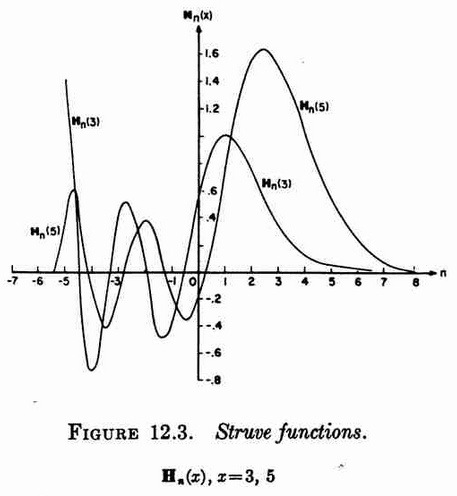Difference between revisions of "Struve function"
| Line 10: | Line 10: | ||
=Properties= | =Properties= | ||
| + | <div class="toccolours mw-collapsible mw-collapsed" style="width:800px"> | ||
| + | <strong>Theorem:</strong> If $x >0$ and $\nu \geq \dfrac{1}{2}$, then $\mathbf{H}_{\nu}(x) \geq 0$. | ||
| + | <div class="mw-collapsible-content"> | ||
| + | <strong>Proof:</strong> █ | ||
| + | </div> | ||
| + | </div> | ||
| + | |||
| + | <div class="toccolours mw-collapsible mw-collapsed" style="width:800px"> | ||
| + | <strong>Theorem:</strong> The following formula holds: | ||
| + | $$H_{\nu}(z)=\dfrac{2(\frac{z}{2})^{\nu+1}}{\sqrt{\pi}\Gamma(\nu+\frac{3}{2})} {}_1F_2 \left( 1; \dfrac{3}{2}+\nu,\dfrac{3}{2};-\dfrac{z^2}{4} \right),$$ | ||
| + | where $\mathbf{H}_{\nu}$ denotes a [[Struve function]], $\pi$ denotes [[pi]], and $\Gamma$ denotes the [[gamma function]]. | ||
| + | <div class="mw-collapsible-content"> | ||
| + | <strong>Proof:</strong> █ | ||
| + | </div> | ||
| + | </div> | ||
| + | |||
<div class="toccolours mw-collapsible mw-collapsed"> | <div class="toccolours mw-collapsible mw-collapsed"> | ||
<strong>Theorem:</strong> The Struve function $H_n$ solves the following nonohomogeneous [[Bessel]] differential equation | <strong>Theorem:</strong> The Struve function $H_n$ solves the following nonohomogeneous [[Bessel]] differential equation | ||
Revision as of 18:37, 28 June 2015
The Struve functions are defined by $$\mathbf{H}_{\nu}(z)=\left(\dfrac{z}{2}\right)^{\nu+1} \displaystyle\sum_{k=0}^{\infty} \dfrac{(-1)^k\left(\frac{z}{2}\right)^{2k}}{\Gamma(k+\frac{3}{2})\Gamma(k+\nu+\frac{3}{2})}$$
Contents
Properties
Theorem: If $x >0$ and $\nu \geq \dfrac{1}{2}$, then $\mathbf{H}_{\nu}(x) \geq 0$.
Proof: █
Theorem: The following formula holds: $$H_{\nu}(z)=\dfrac{2(\frac{z}{2})^{\nu+1}}{\sqrt{\pi}\Gamma(\nu+\frac{3}{2})} {}_1F_2 \left( 1; \dfrac{3}{2}+\nu,\dfrac{3}{2};-\dfrac{z^2}{4} \right),$$ where $\mathbf{H}_{\nu}$ denotes a Struve function, $\pi$ denotes pi, and $\Gamma$ denotes the gamma function.
Proof: █
Theorem: The Struve function $H_n$ solves the following nonohomogeneous Bessel differential equation $$x^2y(x)+xy'(x)+(x^2-n^2)y(x)=\dfrac{4(\frac{x}{2})^{n+1}}{\sqrt{\pi}\Gamma(n+\frac{1}{2})}.$$
Proof: █
Theorem
The following theorem holds: $$\mathbf{E}_0(z)=-\mathbf{H}_0(z),$$ where $\mathbf{E}_0$ denotes a Weber function and $\mathbf{H}_0$ denotes a Struve function.
Proof
References
Theorem
The following formula holds: $$\mathbf{E}_1(z)=\dfrac{2}{\pi}-\mathbf{H}_1(z),$$ where $\mathbf{E}_1$ denotes a Weber function and $\mathbf{H}_1$ denotes a Struve function.
